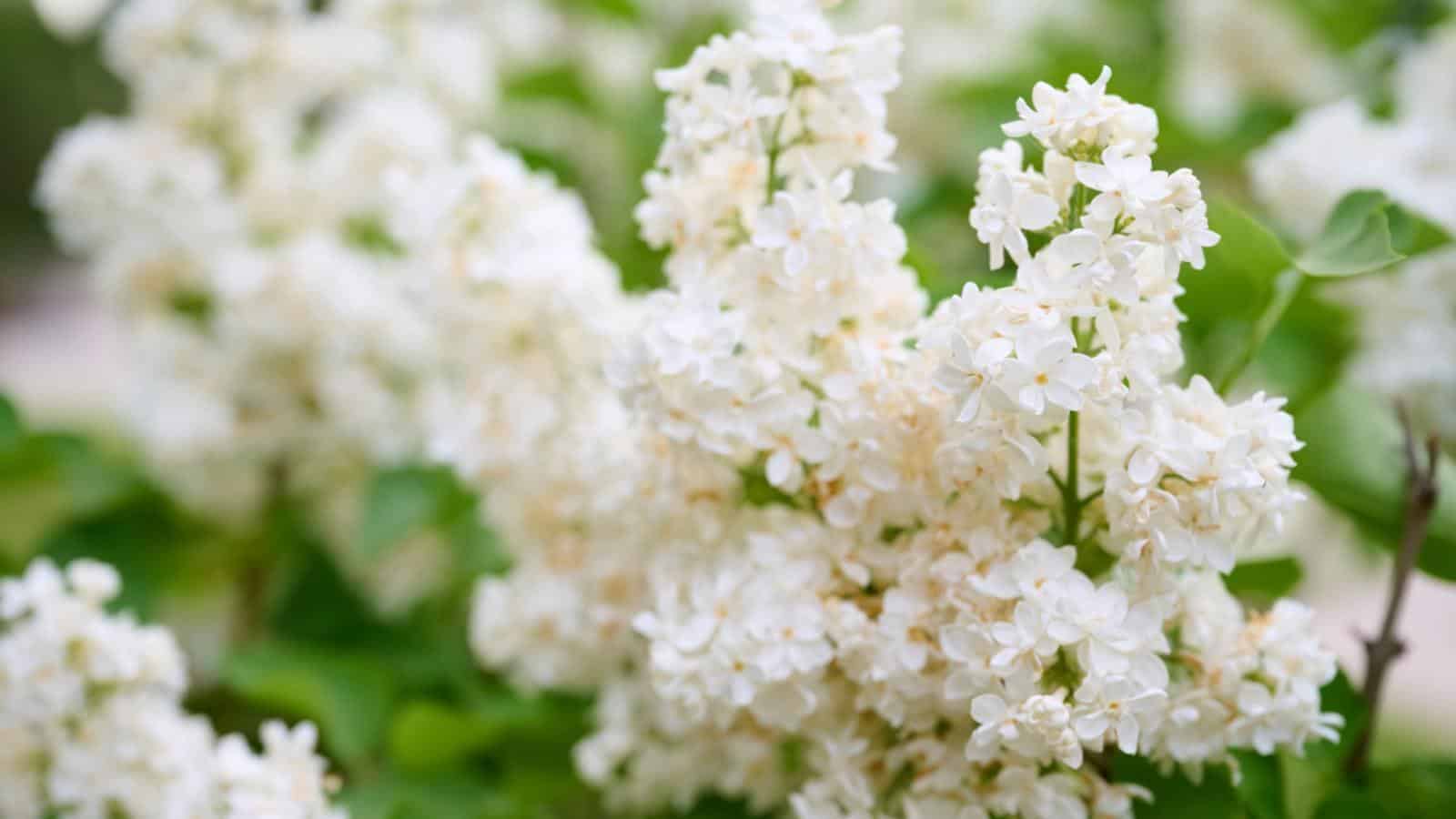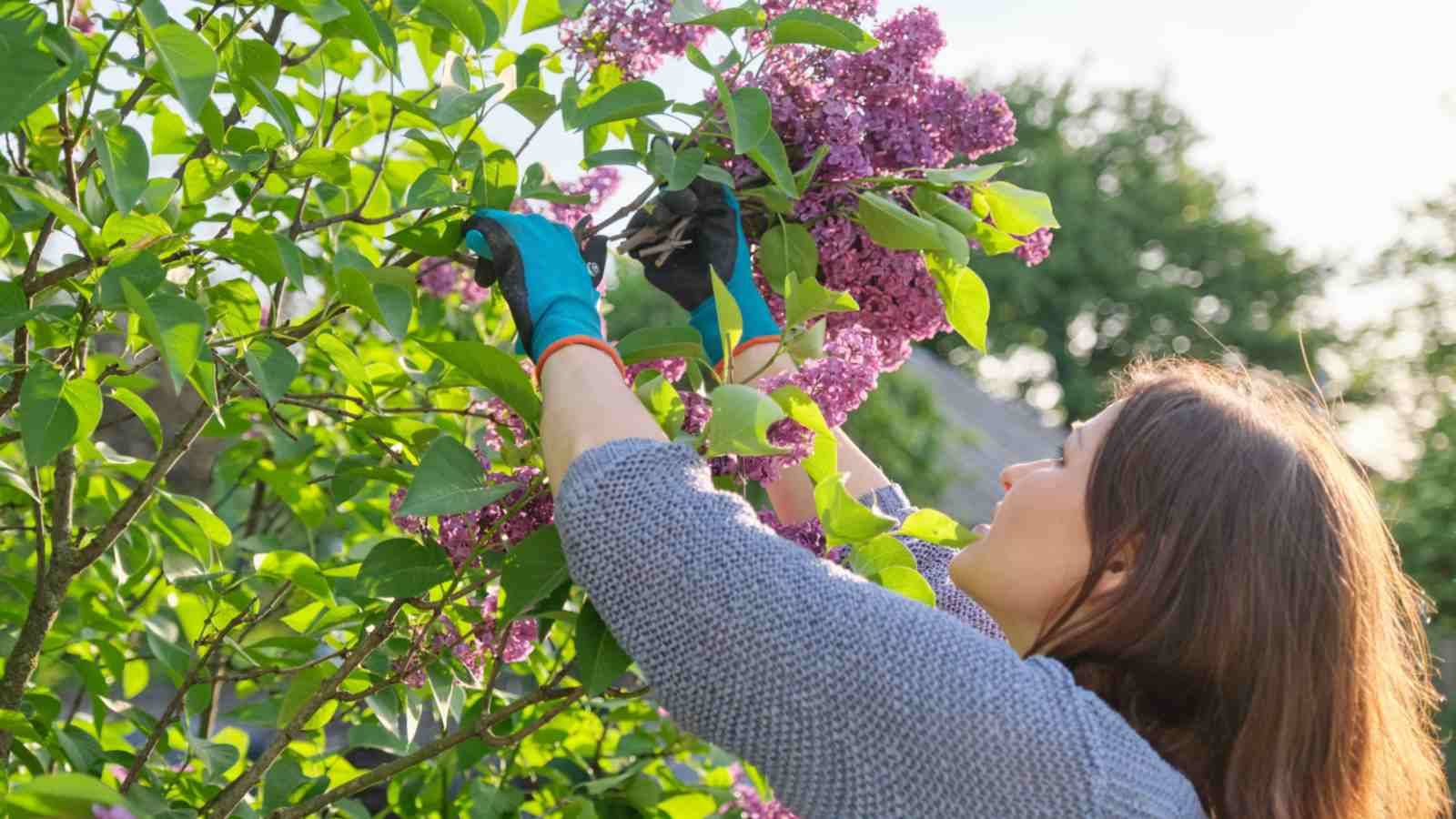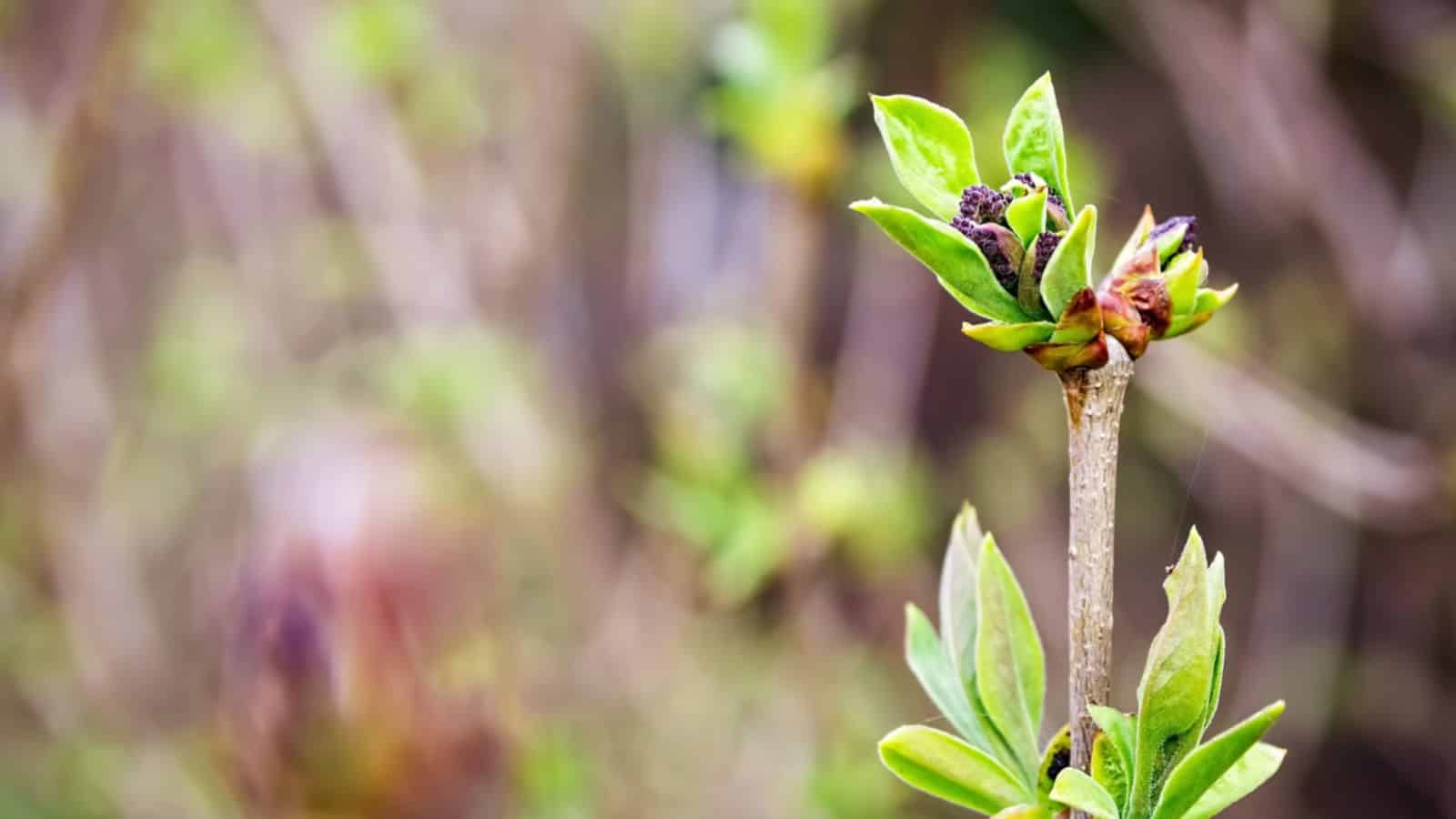Have you ever strolled through a garden and been captivated by a lilac bush’s delicate aroma and vibrant hue? This enchanting plant, known for its fragrant flowers and elegant presence, has graced gardens for centuries, weaving its magic into the hearts of nature enthusiasts.
Picture this: a sunny afternoon, a gentle breeze carrying the sweet scent of lilacs. These deciduous shrubs, scientifically classified under the genus Syringa, are renowned for their panicles of blossoms. The flowers, ranging from pure white to deep purple, boast a mesmerizing fragrance that fills the air. Lilac bushes are typically medium to large, with branches adorned with lush, heart-shaped leaves. One of their intriguing features is their ability to attract butterflies and bees, creating a lively, buzzing ambiance in gardens.
The lilac bush, like a diverse family, comes in various species and hybrids. Some popular types include the Common Lilac (Syringa vulgaris), Persian Lilac (Syringa x persica), and the more recent Bloomerang Lilac (Syringa ‘Bloomerang’). While the Common Lilac hails from Southeastern Europe, the Persian Lilac originates in Eastern Europe and temperate Asia. This bush has also found its way to North America, enhancing gardens across the continent with elegance and charm.
Beyond their ornamental appeal, lilac bushes have a rich tapestry of uses. In traditional medicine, lilac extracts have been employed for their medicinal properties, ranging from alleviating skin ailments to promoting relaxation. Culturally, these blossoms have been symbols of love, renewal, and confidence in the language of flowers. In various cultures, lilacs hold different meanings – from representing youthful innocence to signifying the first emotions of love. Their vibrant presence in festivals and weddings amplifies the joyous atmosphere, making them a cherished part of celebrations.
Now, the burning question – how can you cultivate this enchanting lilac bush in your own garden? The secret lies in understanding its needs. As a master gardener, I’ve gathered much knowledge about these captivating plants. In this guide, I’ll unveil the secrets of lilac bushes, providing you with all the necessary information and care tips to cultivate them effortlessly.

Botanical Name: Syringa
Common Name: Lilac Bush, Lilac Shrub
Family: Oleaceae
Plant Type: Deciduous Shrub
Hardiness Zones: Lilac bushes are hardy in USDA Zones 3 to 7, although specific varieties might have slightly different zone requirements.
Sun Exposure: Full Sun to Partial Shade
Soil Type: Well-draining, Loamy Soil
Soil pH: 6.0-7.0 (slightly alkaline to neutral soil)
Maturity: within 3 to 5 years after planting
Height: 5 to 15 feet in height
Spacing: 5 to 15 feet apart
Bloom Time: Late spring to early summer
Flower Color: Shades of purple, lavender, pink, white, and yellow
Bark color: Gray to grayish brown
Native Area: Southeastern Europe and parts of Asia
Lilac Bush Plant Care
Caring for lilac bushes involves understanding their needs and appreciating their natural beauty. To ensure your lilac bushes thrive, it’s vital to plant them in well-draining, loamy soil. These deciduous shrubs prefer full sun to partial shade, so choose a location in your garden that receives ample sunlight during the day. Regarding soil pH, lilac bushes thrive in slightly alkaline to neutral conditions, with an optimal pH range between 6.0 and 7.0.
Proper spacing is essential for their growth. When planting lilac bushes, maintain a spacing of 5 to 15 feet apart, considering the specific variety’s mature size. Adequate space ensures good air circulation, reducing the risk of diseases and promoting healthy growth. Regular pruning, typically after the blooming season, helps maintain the shape of the bush and encourages new growth, leading to a profusion of blossoms in the following seasons.

Watering lilac bushes deeply and consistently, especially during dry spells, is crucial for younger plants. Mulching around the bush’s base helps retain moisture, regulates soil temperature, and suppresses weeds. A layer of organic mulch, such as compost or wood chips, enhances the overall health of your lilac bushes.
Understanding the bloom time of your lilac variety is essential for their care. Different lilac species and hybrids bloom at slightly different times, generally in late spring to early summer. Regular deadheading, or removing spent flowers, keeps the bush looking tidy and directs the plant’s energy into producing new blossoms for the following year.
Paying attention to these key aspects of care will reward you with the breathtaking sight and delightful fragrance of lilac blossoms, making your garden a haven of natural beauty and charm.
Light
These enchanting shrubs, often celebrated for their vibrant blossoms, thrive best in locations with full sun to partial shade. Adequate sunlight is essential for photosynthesis, enabling the lilac bush to produce the energy it needs for healthy growth and abundant flowering.
When planting lilac bushes, selecting a spot in your garden that receives at least 6 hours of direct sunlight per day is crucial. Full sun exposure ensures robust blooming and lush foliage. However, lilacs can tolerate partial shade, especially in regions with intense summer heat. In such areas, providing them with a few hours of morning sunlight or dappled shade in the afternoon can protect them from the scorching sun while still allowing them to flourish.
Insufficient sunlight can lead to leggy growth and fewer blossoms. Therefore, if your garden doesn’t receive ample sunlight, consider pruning nearby trees or plants to allow more light to reach your lilac bushes. By fulfilling their light requirements, you’ll witness your lilac bushes transform into healthy, blooming wonders, gracing your garden with their irresistible charm and fragrance.

Soil
Lilac bushes thrive in well-draining, loamy soil rich in organic matter. A soil composition that allows water to permeate easily preventing waterlogging, is crucial to prevent root rot and other water-related issues.
In terms of pH, lilac bushes prefer slightly alkaline to neutral soil. The ideal pH range for these plants falls between 6.0 to 7.0. If your soil is too acidic, you can amend it by adding garden lime, which helps raise the pH level, creating a more favorable environment for lilac growth. Regularly testing the soil’s pH and making necessary adjustments ensures that your lilac bushes have the best conditions for robust growth and prolific blooming.
Additionally, mulching around the base of the lilac bush can significantly benefit the soil. A layer of organic mulch, such as compost or wood chips, conserves soil moisture and enriches the soil as it decomposes, providing essential nutrients to the plant. Proper soil preparation and maintenance not only support the lilac bushes in their growth but also contribute to the longevity and vitality of these charming additions to your garden.

Water
These hardy shrubs, while resilient, benefit from consistent and deep watering, especially during dry spells or hot weather. When watering lilac bushes, the key is to ensure the soil around the roots stays consistently moist but not soggy. Young lilac bushes, in particular, need regular watering to establish strong root systems. Water deeply, allowing the water to penetrate the soil to the root level. A thorough soaking once or twice a week is generally sufficient, but the frequency might vary based on your local climate and soil conditions.
Mulching around the base of the lilac bush helps retain moisture, regulates soil temperature, and reduces weed competition, ensuring the plant receives adequate water. Aim to maintain a layer of organic mulch around the base, like compost or wood chips, but be cautious not to pile it against the trunk, as it can lead to rot.
During prolonged periods of drought, pay extra attention to your lilac bushes. Increasing the watering frequency if you notice the leaves wilting or the soil becoming excessively dry. However, it’s equally important not to overwater, as waterlogged soil can lead to root rot and other issues.

Temperature and Humidity
Lilac bushes are remarkably hardy, thriving in a wide range of temperatures. However, they prefer temperate climates and can withstand cold winters, making them well-suited for USDA Hardiness Zones 3 to 7.
During winter, lilac bushes require a period of cold dormancy to produce abundant blossoms in spring. Adequate exposure to chilling temperatures, typically below 45°F (7°C), is essential for their flowering process. While they can withstand cold weather, late spring frosts can damage tender buds, potentially affecting the blooming season.
When it comes to humidity, lilac bushes are relatively adaptable. They can tolerate various humidity levels, making them suitable for various regions. However, good air circulation is crucial to prevent the development of fungal diseases, especially in humid climates. Proper spacing between bushes, regular pruning, and avoiding overhead watering can help maintain optimal air circulation, ensuring the lilac bushes remain healthy and disease-free.

Fertilizer
Lilac bushes generally benefit from a balanced fertilizer, preferably one with a ratio of equal parts nitrogen (N), phosphorus (P), and potassium (K). Look for a well-balanced, slow-release granular fertilizer specifically formulated for flowering shrubs.
The timing of fertilization is crucial. It’s best to apply fertilizer for established lilac bushes in early spring, just as new growth begins. Sprinkle the fertilizer evenly around the bush’s base, avoiding direct contact with the stem. Water the area thoroughly after application to help the nutrients penetrate the soil and reach the roots.
Young or newly planted lilac bushes require a slightly different approach. In their first year, these plants benefit from a phosphorus-rich fertilizer to encourage strong root development. Incorporate a high-phosphorus fertilizer, such as one with a ratio of 5-10-5, into the planting hole or apply it as a top dressing in early spring.
Remember, over-fertilization can be harmful, leading to excessive foliage growth at the expense of flowers. It’s crucial to follow the recommended dosage mentioned in the fertilizer package. Regular monitoring of your lilac bushes, along with a well-balanced feeding regimen, will result in robust, healthy plants adorned with a profusion of captivating flower clusters, enhancing the beauty of your garden.

Pruning
The best time to prune lilac bushes is right after they finish blooming, usually in late spring to early summer. This timing allows you to remove spent blossoms and shape the bush without compromising the next year’s flower buds, which form soon after blooming.
Start by removing dead or diseased branches cutting them back to the main stem or a healthy lateral branch. Thin out crowded or weak shoots to encourage better air circulation, reducing the risk of diseases. Older lilac bushes benefit from rejuvenation pruning, where about one-third of the oldest, thickest stems are removed at ground level. This practice encourages the growth of new, vigorous shoots.
When pruning, use sharp, clean tools to make precise cuts. Aim for a natural, open-centered shape, allowing sunlight to penetrate the interior of the bush, stimulating healthy growth. Avoid severe pruning, especially on mature lilac bushes, as this can reduce flowering for several years.

Overwintering
Preparing your lilac bushes for the winter months is essential to ensure their resilience and vitality come spring. While lilac bushes are hardy, providing them with little care during the winter can significantly affect their overall health. One of the primary concerns during winter is protecting the lilac’s shallow root system from extreme cold and frost heave, where the soil freezes and thaws, pushing the plant upwards.
To safeguard the roots, apply a layer of mulch around the base of the lilac bush in late fall. A thick layer of organic mulch, such as straw or shredded leaves, provides insulation, keeping the soil temperature stable and preventing sudden temperature fluctuations that can stress the plant. Mulch also helps retain moisture, which is crucial during the dry winter.
Pruning is another aspect of overwintering. While lilac bushes don’t require extensive pruning in winter, removing dead or diseased branches is advisable. This not only promotes good air circulation but also prevents diseases from spreading. Additionally, if your lilac bush has grown overly dense, selectively thinning out branches during winter can help sunlight reach the center of the plant, ensuring even growth.
Lastly, remember to water your lilac bushes adequately before the ground freezes. Proper hydration is crucial, especially in regions where winter precipitation might not provide enough moisture. Deep watering helps the plant sustain itself during the dormant winter period.

Types of Lilac Bush
Common Lilac (Syringa vulgaris)

The Common Lilac, Syringa vulgaris, is the quintessential choice for many gardeners. Its large, fragrant clusters of flowers, ranging from shades of purple to pink and white, define the lilac’s charm. Its fragrant blooms attract pollinators such as butterflies and hummingbirds. This is a splendid option where the fragrance can be savored within a hedge, as a privacy screen, or as an individual plant in butterfly gardens, cottage gardens, and areas designed for cut flowers.
Charles Joly Lilac (Syringa vulgaris ‘Charles Joly’)

A standout cultivar, ‘Charles Joly,’ is distinguished by its deep purple, double-petaled blossoms and strong, sweet fragrance. This French Lilac variety is a garden jewel, adding elegance and aroma to any landscape.
Monge Lilac (Syringa vulgaris ‘Monge’)

Another notable cultivar, ‘Monge,’ boasts vibrant, reddish-purple blooms and a delightful scent. Its rich hue and captivating fragrance make it a prized addition to gardens.
Firmament Lilac (Syringa vulgaris ‘Firmament’)

‘Firmament’ is celebrated for its unique blue-lavender flowers, a rare hue among lilacs. Its mesmerizing color and classic lilac scent make it a coveted choice for enthusiasts seeking something distinct.
Miss Canada Lilac (Syringa ‘Miss Canada’)

‘Miss Canada’ is characterized by its striking red buds that open into pinkish-red blossoms. This cultivar stands out with its vibrant color and is a favorite for its showy display.
Donald Wyman Lilac (Syringa vulgaris ‘Donald Wyman’)
‘Donald Wyman’ lilac bushes feature dark purple buds that unfurl into single, fragrant, lavender-pink flowers. Its elegant appearance and sweet aroma make it a cherished variety.
Korean Lilac (Syringa oblata ‘Betsy Ross’)
For regions with milder winters, ‘Betsy Ross’ Korean Lilac, a selection from Syringa x oblata, blooms early with pale pink to lavender blossoms, adding a touch of grace to the garden.
Dwarf Korean Lilac (Syringa ‘Miss Kim’)

Syringa ‘Miss Kim,’ also known as Miss Kim Lilac, is a delightful dwarf Korean Lilac variety. It showcases fragrant, lavender-pink flowers and compact growth, perfect for smaller landscapes.
Cutleaf Lilac (Syringa laciniata)

Syringa laciniata, commonly known as Cutleaf Lilac, adds an artistic touch to gardens with its finely cut leaves and fragrant, pale purple blooms. Its unique foliage sets it apart, adding visual interest to any garden setting.
Chinese or Rouen Lilac (Syringa chinensis)

Chinese or Rouen Lilac (Syringa chinensis) is a captivating variety known for its exquisite fragrance and delicate white to purple flowers. Its graceful appearance adds a touch of elegance to gardens and landscapes.
Japanese Tree Lilac (Syringa reticulata)

Japanese Tree Lilac, Syringa reticulata, is celebrated for its elegant, creamy-white blossoms in large panicles. A small tree rather than a shrub offers a unique lilac experience with a delightful fragrance.
Other Decorative and Dwarf Varieties

Other popular lilac selections for gardeners include Chinese Lilac (Syringa × chinensis), Dwarf Korean Lilac (Syringa meyeri), Early Hybrid Lilac (Syringa x hyacinthiflora), Persian Lilac (Syringa × persica), and Preston Lilac (Syringa x prestoniae). Each of these varieties presents its unique combination of colors, fragrances, and growth habits, allowing gardeners to choose the perfect lilac for their specific preferences and gardening needs.
How to Plant Lilac Bush From Seed
Planting a lilac bush from seed can be a rewarding and fulfilling experience, allowing you to nurture a beautiful flowering shrub right from its infancy. Following these step-by-step guidelines, you can embark on this exciting journey and watch your lilac flourish into a magnificent bush, gracing your garden with its vibrant colors and enchanting fragrance.
Step 1: Preparing the Seed
Begin your lilac-growing adventure by acquiring high-quality lilac seeds from a reputable source or nursery. Before planting, it’s essential to stratify the seeds, mimicking the winter conditions they would naturally experience. To stratify, place the seeds in a moist paper towel inside a plastic bag and refrigerate them for about 30 days. This process prompts the seeds to break their dormancy, ensuring successful germination.
Step 2: Planting the Seed
Once stratification is complete, choose loamy soil with good drainage for planting. Create a small indentation in the soil and place the stratified seed about half an inch deep. Cover it gently with soil and pat it down lightly. Water the area thoroughly to ensure the soil settles around the seed, providing a snug environment for germination and root growth.
Step 3: Providing the Right Conditions
Lilac seeds require consistent moisture and warmth to sprout. Keep the soil consistently moist but not soggy. To maintain warmth, you can cover the planted area with a thin layer of mulch, which also helps retain moisture. Place the planting container in a location that receives indirect sunlight, ensuring the seeds are protected from harsh weather conditions.

Step 4: Addressing Common Pests and Problems
As your lilac seedlings grow, watch for common pests like aphids and diseases like powdery mildew. Regularly inspect the leaves for any signs of trouble; if detected, address the issues promptly. Neem oil or insecticidal soap can be effective against pests while ensuring proper air circulation around the plants can prevent mildew problems.
Step 5: Flowering and Aftercare
With patience and care, your lilac seedlings will transform into mature bushes. Once they reach a suitable size, typically after a couple of years, they can be transplanted into their permanent location in the garden. Lilacs generally start flowering after a few years of growth. Pruning, especially after flowering, helps maintain their shape and encourages more blossoms in the following years.

How to Propagate Lilac Bush
If you’ve ever dreamed of multiplying the charm of your garden with more lilac bushes, propagating them might be the perfect gardening adventure for you. The process can be exciting and rewarding with various methods at your disposal. Let’s delve into the secrets of propagating lilac bushes, sharing practical advice and hands-on techniques to ensure your efforts bloom into a colorful and fragrant success story.
Choosing Propagation Method
Selecting the right propagation method is akin to choosing the right tool for a specific job – it ensures efficiency and success. Lilac bushes can be propagated through several methods, each with unique advantages. The most common techniques are propagation from suckers, softwood cuttings, and air layering.
Propagation from Suckers
One of the easiest ways to propagate lilac bushes is through suckers. These are young shoots that emerge from the base of the mature plant. To propagate using this method, carefully dig out the sucker, ensuring it has some roots attached. Plant it in a well-prepared location, providing ample water and sunlight. With a little patience, these tiny shoots will grow into healthy lilac bushes, mirroring the qualities of the parent plant.
Propagation from Softwood Cuttings
Softwood cuttings offer a reliable method for propagating lilac bushes. During the early summer, select healthy, non-flowering shoots and cut them at a length of about 6 inches. Remove the lower leaves, dip the cut end in rooting hormone, and plant it in a container with a well-draining soil mix. Regular misting and proper care will encourage these cuttings to develop roots. Once they’ve established a strong root system, they can be transplanted into the garden, where they will flourish into beautiful lilac bushes.

Propagation via Air Layering
Air layering is a more advanced but highly effective method for propagating lilac bushes. It involves creating a small wound on a healthy, mature branch, covering it with rooting hormone and moist sphagnum moss, and wrapping it in plastic. Over time, roots will develop in the wounded area. Once the roots are well-established, you can cut the branch below the rooted portion and plant it separately. This method ensures that the new lilac bush has a robust root system, enhancing its chances of successful growth.
Rooting
Whether using suckers, cuttings, or air layering, the rooting stage is pivotal. Providing a well-draining soil mix, proper moisture, and a balanced environment is essential for encouraging the growth of healthy roots. Regular monitoring and care during this stage significantly increase the chances of successful propagation.
Care and Maintenance
Regular care and maintenance are essential once your propagated lilac bushes have taken root and started growing. Pruning, watering, and fertilizing ensure their health and vigor. Regular pruning not only shapes the bush but also promotes flowering. Adequate watering, especially during dry spells, and a balanced fertilizer application in the growing season contribute to their overall well-being.
Finding a Suitable Location
Selecting the right spot in your garden for your propagated lilac bushes is vital. Lilacs generally prefer full sun to partial shade. Ensure the chosen area has well-draining soil and adequate space for the bushes to grow and spread. Loosen the soil in the planting area and dig a hole twice as wide and slightly deeper than the root ball. Good air circulation around the plants helps prevent diseases and ensures healthy growth.

Monitoring for Pests and Diseases
Regular vigilance is essential to spot any signs of pests or diseases early. Aphids, powdery mildew, and lilac borers are common lilac adversaries. Implement natural pest control methods and maintain good hygiene around the plants to minimize the risk of infestations. Regular inspections and prompt action can safeguard your lilac bushes, ensuring their long-lasting beauty in your garden.
With the right methods, care, and patience, propagating lilac bushes can transform your garden into a fragrant haven. By following these steps and understanding the unique needs of lilac propagation, you’ll expand your garden and create a flourishing sanctuary of color and fragrance.
Common Pests and Plant Diseases for Lilac Bush
Aphids

Aphids, those minuscule insects that cluster on the undersides of leaves, are a common nemesis of lilac bushes. These tiny, pear-shaped creatures feed on the plant’s sap, weakening it and causing distorted leaves. While aphid infestations can be alarming, they can be controlled through natural methods. Introducing natural predators like ladybugs and lacewings into your garden can help keep the aphid population in check. A strong blast of water from a hose can also physically remove them. Regularly inspect the underside of leaves, especially during the warmer months, to catch aphid infestations early and prevent significant damage.
Powdery Mildew

Powdery mildew is a common fungal disease affecting lilac bushes, creating a powdery, white substance on the leaves. This unsightly occurrence not only mars the lilac’s appearance but also weakens its ability to photosynthesize effectively. To combat powdery mildew, it’s crucial to ensure proper air circulation around the plant. Prune the lilac to allow air to flow freely through the branches. Watering the plant at the base early in the day can prevent the foliage from staying damp, discouraging the fungus growth. Applying neem oil or a mixture of baking soda and water can also help manage the disease. Regularly inspect your lilac for any signs of powdery mildew, especially during humid weather, and take prompt action to prevent its spread.
Lilac Borers
Lilac borers are stealthy pests that can cause significant damage to lilac bushes by tunneling into the wood. These larvae of clearwing moths burrow into the stems, disrupting the flow of water and nutrients. Signs of infestation include wilting, oozing sap, and small holes in the branches. Preventing lilac borers involves maintaining the plant’s overall health. Regularly prune away dead or damaged wood, as these are entry points for the borers. Keeping the lilac well-watered and properly fertilized helps it resist attacks. If you suspect an infestation, remove and destroy the affected branches, and consider using borer traps to capture the adult moths before they lay eggs.
Leaf Spot Diseases

Leaf spot diseases, caused by various fungi, lead to the appearance of dark spots or lesions on lilac leaves. These spots can merge, causing the leaves to turn yellow and drop prematurely, weakening the plant. Avoid overhead watering to prevent leaf spot diseases, as wet foliage provides an ideal environment for fungi to thrive. Instead, water the base of the plant early in the day. Adequate spacing between plants enhances air circulation, reducing the risk of fungal infections. Remove the affected leaves promptly if leaf spot diseases appear and consider applying fungicidal sprays. Regularly monitoring the lilac’s foliage and practicing good garden hygiene can go a long way in preventing the onset of leaf spot diseases.
Common Plant Problems and Solutions for Lilac Bush
Yellowing Leaves
One common issue many gardeners face with lilac bushes is the yellowing of leaves. This yellowing, often accompanied by poor growth, can indicate nutrient deficiency, particularly a lack of nitrogen in the soil. To address this problem, consider applying a balanced fertilizer with a higher nitrogen content during the growing season. Additionally, incorporating organic matter like compost or well-rotted manure around the base of the plant can enhance soil fertility, promoting healthy foliage. Regularly monitor the color and vigor of the leaves, and timely intervention will ensure your lilac bush regains its lush greenery.
Sparse Blooms
Sparse blooming, where the lilac bush fails to produce abundant flowers, can be disappointing. This issue often arises due to incorrect pruning practices. Lilac bushes bloom on old wood, meaning they develop flower buds in the previous year. Pruning immediately after the flowering season ensures that new shoots have ample time to produce buds for the following year. Avoid excessive pruning, especially in late winter or spring, as it removes potential flower-bearing branches. Regularly remove dead or diseased wood to encourage new growth and optimal blooming.
Root Rot
Root rot, a fungal disease caused by overly wet soil conditions, can seriously threaten lilac bushes. To prevent this issue, ensure the planting area has well-draining soil. Avoid overwatering, especially in poorly draining soil, as stagnant water around the roots creates an ideal environment for root rot. Proper mulching around the base of the plant helps retain moisture without waterlogging the soil. If you suspect root rot, carefully inspect the roots. Diseased roots are often dark, mushy, and lack healthy, white tips. If detected early, pruning affected roots and improving drainage can save the lilac bush from further damage.
FAQs
Do lilac bushes spread?
Yes, lilac bushes can spread, especially through suckering. Suckers are shoots that emerge from the base of the mature plant. Proper pruning and maintenance can control their spread, ensuring the lilac bush doesn’t take over unwanted areas in your garden.
Where do lilac bushes grow best?
Lilac bushes thrive in well-draining soil and prefer full sun to partial shade. They grow best in regions with cold winters, requiring winter chill for optimal flowering. Plant them in locations with good air circulation to prevent diseases.
Are lilac bushes high maintenance?
Lilac bushes are relatively low-maintenance once established. They require regular pruning to maintain their shape and promote flowering. Adequate watering, especially during dry spells, and occasional fertilization in the spring contribute to their overall health. Regular inspection for pests and diseases ensures they remain vibrant.
How big does a lilac bush get?
The size of a lilac bush varies based on the specific species or cultivar. Common lilacs (Syringa vulgaris) can reach a height of 8 to 15 feet and spread about 6 to 12 feet. Compact varieties, such as the Dwarf Korean Lilac (Syringa meyeri ‘Palibin’), stay smaller, around 4 to 5 feet in height, making them ideal for smaller gardens or containers.
When to trim lilac bushes?
The best time to trim lilac bushes is immediately after they finish flowering, usually in late spring or early summer. Pruning during this period allows the plant to develop new shoots and flower buds for the following year. Remove dead or diseased branches and cut back older stems to promote new growth and maintain a healthy, shapely lilac bush.
Other Guides from Planet Natural:











